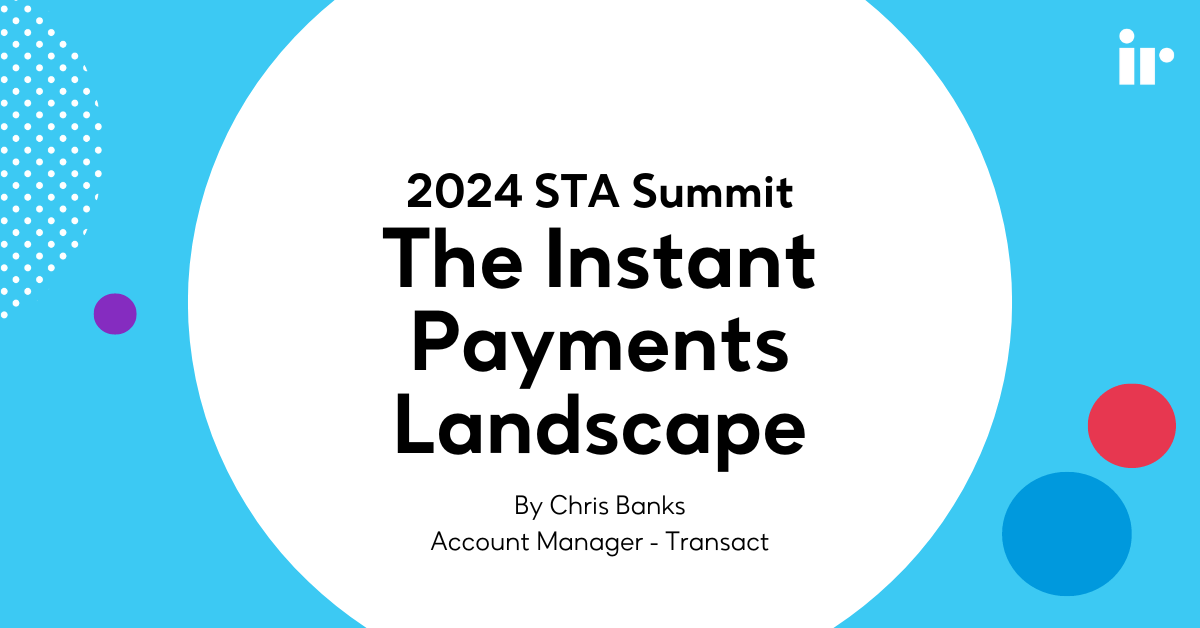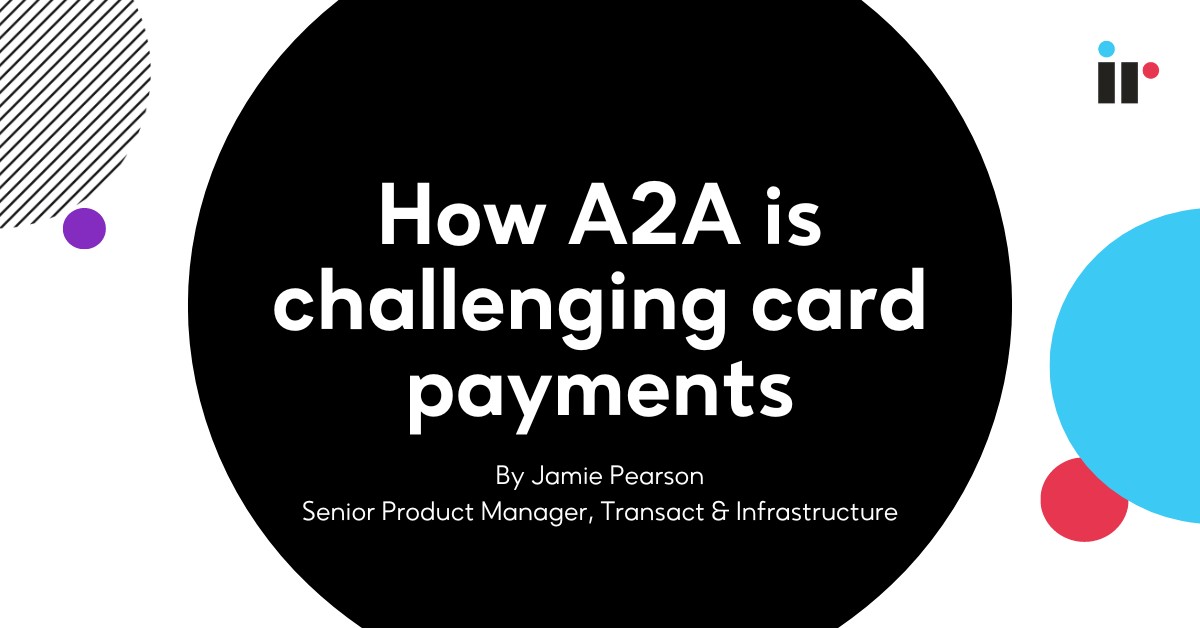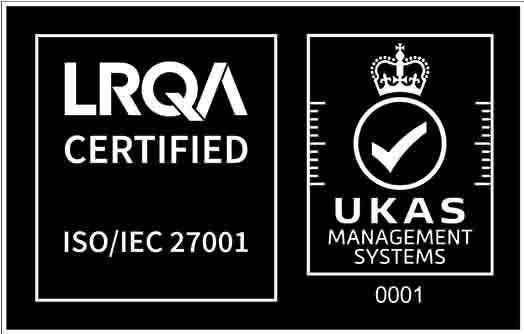The rapid evolution of the payments space means consumers are demanding more choices as to how they engage with retailers. With multiple payment channels now available, and an increasingly competitive marketplace, it means payment acquirers and service providers must ramp up the focus on customers, putting them squarely at the heart of their business.
Download a PDF copy of our Managing your Changing Payments Business guide
What is an SLA?
A service-level agreement (SLA) spells out exactly what level of service is expected from a service provider. It defines the metrics by which services are measured, as well as remedies or penalties if the agreed-on service levels are not achieved. It's a critical component of any technology vendor contract, as it can affect business results by falling short of performance targets.
In the payments space, an SLA is a contractually binding agreement that documents the performance standard and service quality agreed to between the bank and service provider. The service level agreement ensures that the institution receives the needed services at the required performance price and standard.
Service level agreements are a key element in managing the financial and operational risk associated with outsourcing contracts and specific services. It also can also help mitigate risk. By defining the measurement unit and service range for the chosen level, it lessens the risk of poor service by becoming an area of focus and is assigned as the key responsibility for a service provider.
Not delivering on an SLA, or ineffective management of the fall out of processing issues, can result in a breach of trust between the customer and the provider. Such breaches quite understandably reduce the chance of those impacted trusting the bank with future business or recommending the service to others.
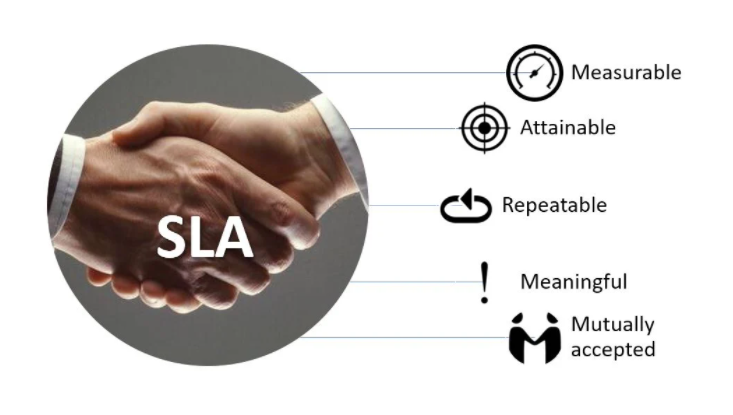
Payments are no longer purely transactional, and leading businesses as well as merchant acquirers, are recognizing that delivering on service level agreements (SLAs) is critical to delivering a fast and frictionless experience for all parties involved.
Service level (SLA) management: How to set metrics
Service level agreements use these metrics to measure a wide variety of components. For proper SLA management, it's important when selecting metrics, to establish that they're fair to both parties, and that the metrics are within the service provider’s control.
Key Performance Indicators (KPIs)
Key performance indicators are the common SLA metrics chosen to measure a defined set of services performed against agreed standards.
Finally, it's important to specify a baseline for the key performance indicators in the service level agreement. This baseline must be reasonable, but the SLA can be reviewed when more data on that metric has been collected.
How will businesses cope with the challenges of a changing payments world?
SLA management: Developing SLAs in banking
While many factors determine how the bank and its service provider will undertake management of the quality of services, there are some basic steps to help identify the most essential requirements for those services. These steps help translate the requirements into measurable and accountable performance standards:
Determining objectives
The first step in creating service level agreements is determining the SLA management standards that service providers need to meet to help the bank attain its strategic goals. The bank should consider each critical component of the services, and the relationship of the services provided to other systems, applications, and functions For each activity, function, and process, all parties need a clear objective to understand what constitutes success.
Defining requirements
To reach strategic goals, service providers and financial institutions need to identify exactly how the objectives will be achieved. While objectives are the broad statements geared towards achieving goals, performance requirements are targeted at specific services to ensure the objective is met.
Setting measurements
In formulating an agreement, the bank can identify specific measurements to indicate if an SLA is meeting the prescribed requirements. The metrics that correspond to the performance requirements represent tangible or quantifiable deliverables that can be monitored. Target metrics should be established based on specific tolerance levels and the minimum acceptable levels of service. Setting a minimum acceptable level of service also defines the point of significant failure.
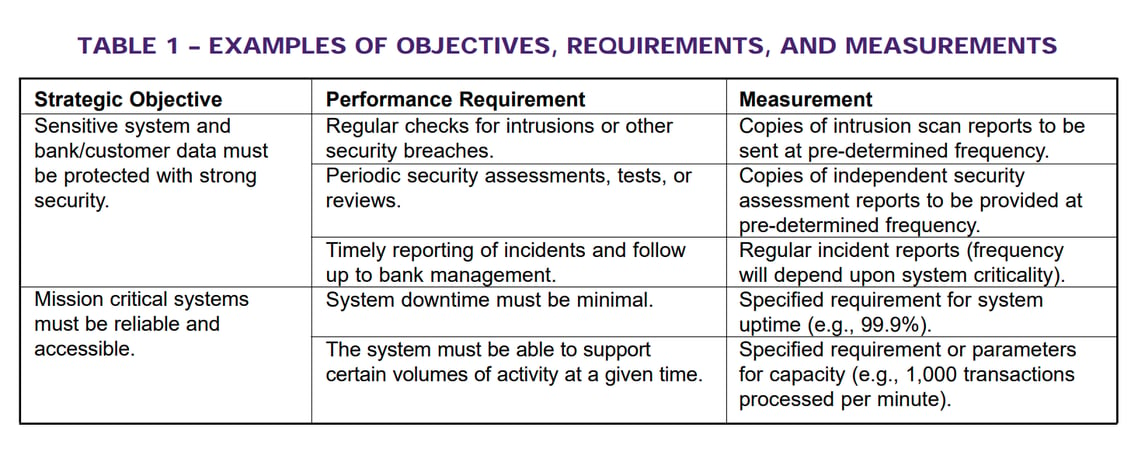 Image source: Bank technology bulletins
Image source: Bank technology bulletins
Establishing accountability
Clear definitions of accountability are important to ensure that both the company and the service provider understand their management roles and responsibilities for each service level requirement. Establishing accountability can involve incentives (to motivate a service provider) and penalties (for any defined service delivery failures). Below is an example of a service level agreement (for illustration purposes only).
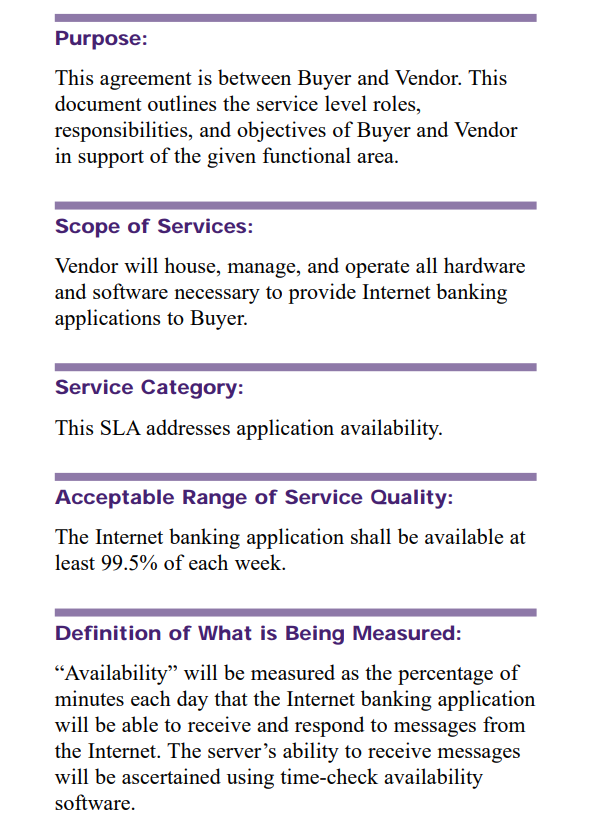 Image source: Bank technology bulletins
Image source: Bank technology bulletins
SLA management: Developing SLAs in retail payments
Payments are no longer purely transactional, and leading businesses as well as merchant acquirers, are recognizing that delivering on a customer based SLA is critical to delivering a fast and frictionless experience for all customers and companies.
The changing payments landscape and the rapid adoption of cloud services means the evolution of eCommerce capabilities, payment hubs and multi-channel as well as omni-channel payment experiences. These days, a customer will research and review an item up to 12 times before finally deciding to buy it – and, in many cases, won’t buy from the place they first looked.
Multi-channel payments offer customers various online or mobile channels through which to pay. A bricks-and-mortar store for example which offers customers the option of buying on their eCommerce store, or a marketplace like Amazon, or a social media network like Facebook.
Omni-channel is all about merchants melding shopping experiences and payment touch points across their physical store, eCommerce site, mobile app and other places. It means a seamless shopping experience for customers by offering alternative payment methods, comprehensive searchability, embedding loyalty coupons and discounts, free-return or free delivery facilities in their apps.
Encouraged by market players like Amazon, Facebook and Google and as reported by many retailer associations, more and more consumers demand more convenient shopping with access to a global retailing market place, and all the services they prefer to be offered by merchants, independent of the channel they purchase from.
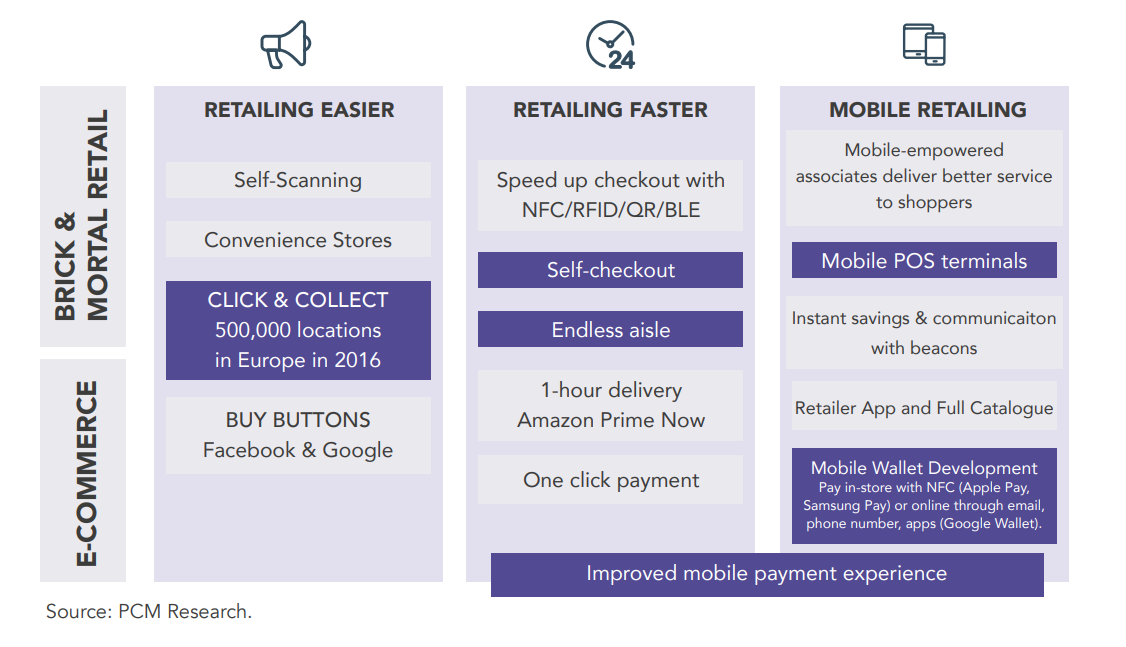
SLA management: Developing a cloud SLA
With cloud computing adoption rapidly increasing, service level agreements are essential if you decide to integrate a cloud environment into your company. A cloud SLA contract outlines what the provider and customer are responsible for in regards to using the service. The contract lets the company, the service provider and the customer know upfront what specifically will be managed. SLA management can be complex, but here are some basic guidelines to look out for in cloud service level management.
Availability
The most important Quality of Service (QoS) concept that should be covered in any service level agreement is the service providers promised availability. For example, they might promise 99.99% availability during business hours, quality of speed, average speed, time service factor, missed deadlines etc. Terms should also include the what support the service provider offers for unexpected downtime.
Data ownership
The question of who owns data in the cloud prevents many enterprises from making the jump to the cloud, especially when they consider tracking sensitive data. An SLA contract should specifically outline data ownership policies for transparency and clarity. Ideally, an SLA should define all ownership rights, but the user should expect to retain those rights.
Cloud hardware and software
While cloud service providers don't all offer the same services, they all require the use of hardware and (potentially) software to operate those services. The provider should outline the hardware that the cloud services rely on, including servers and other devices. SLA management involves knowing your cloud’s equipment and software specifications. This will help you understand the specifics behind your cloud environment’s construction and operation, and what you’ll need to educate your employees on.
Disaster recovery and backup
Cloud service providers should have a plan in place to prevent total loss of your data. The SLA should describe their disaster recovery and backup solutions in detail. Depending on the provider and the contract, they may provide automatic backups and snapshots to report on your data. If the user is required to set up backup and recovery systems, the SLA contract should outline that.
Customer responsibilities
Your cloud service provider needs to inform you of what you’re liable for when you enter the contract. Make sure you study the entirety of the SLA to know what your provider will manage and what you need to as a customer, to allow you to identify any breach of the contract should it occur.
Advanced analytics for better targeting
Advanced analytics, applied to tracking data generated by customer transactions and digital banking, can be used to increase the effectiveness SLA management. Analytics provides more information that allows companies to develop insights on customer segments and behaviors, for example analyzing cart abandonment rate. The impact can be an increase in sales productivity of as much as 40 percent.
Using data-mining techniques on spending patterns and online behaviors, companies can identify high-value and high-potential customer groups. They can identify granular behavioral clusters and align targets for sales and value generated, as well as service level and cost to serve. Customer behavior analysis can also be used to optimize lead generation, enabling organizations to focus on the right customer group at the right time.
SLA monitoring: Helping deliver on service level agreements
The biggest problem any organizations face in figuring out which customers and payments are affected when there is a technical glitch, is that they are often not actually monitoring the payments but the systems and processes they go through.
As the payment processing environment continues to evolve, it will become even more complex, and data isn't always easily collected. Many merchants still have legacy systems supporting bolt-on technology, system duplication and siloed technology. The added complexity of cross-border payments can create a less than efficient situation in which to deliver on service level agreements.
Real-time intelligence and actionable insights
IR's Transact suite of performance monitoring solutions bring deep, real-time visibility to your entire payments environment and help put you in control of SLA management.
Real time monitoring offers unparalleled insights into payment processing, payments transactions and trends. With in-depth analytic and troubleshooting capabilities, you can optimize, improve customer experience, innovate and minimize risk.
Merchants and merchant acquirers are having to contend with worldwide changes and the rapid growth of technology, so payment transaction monitoring to help fulfil company and customer level SLA is without doubt a necessary part of global payments technology.
Have a listen to our podcast on how historical data can help real time analytics in payments technology




